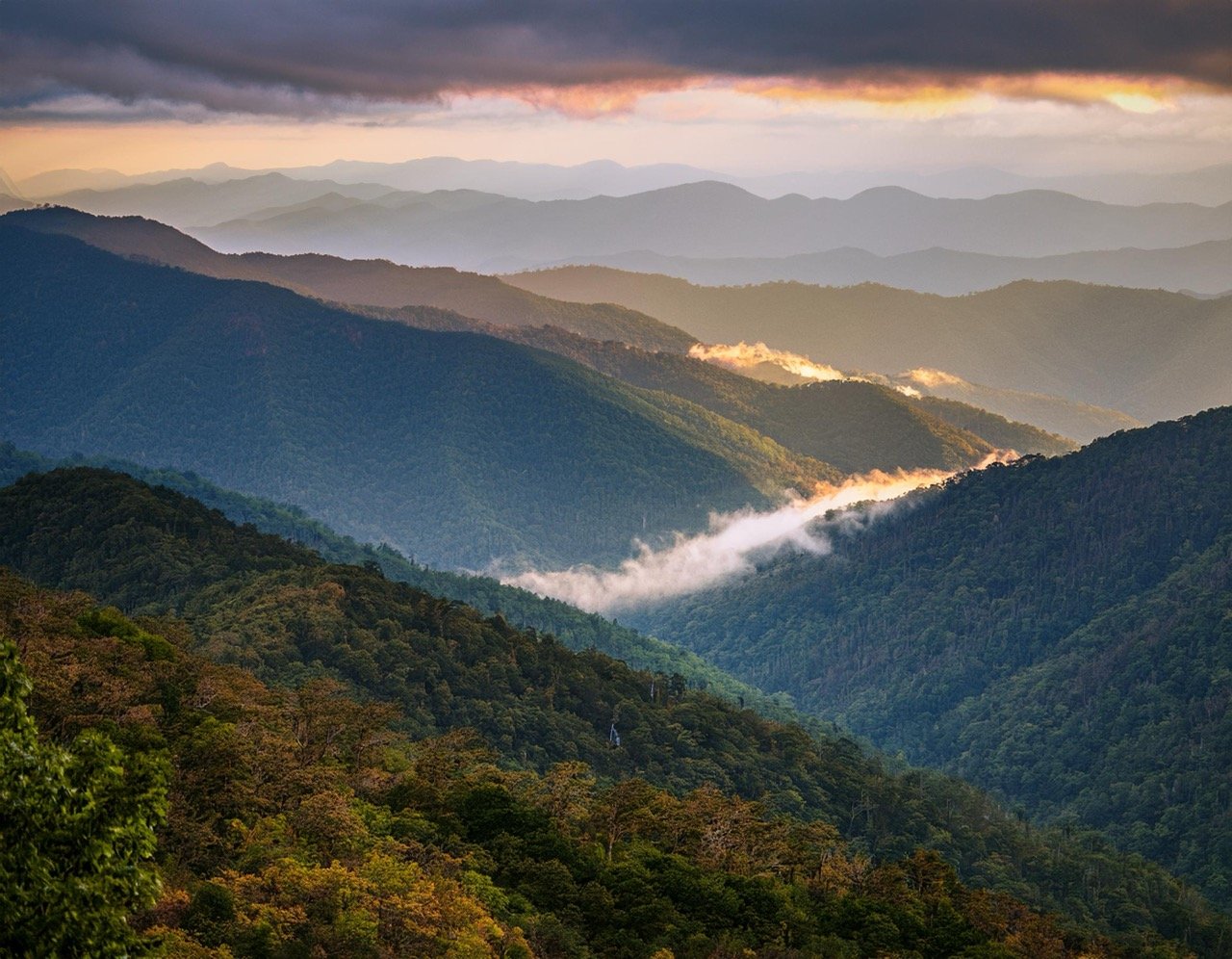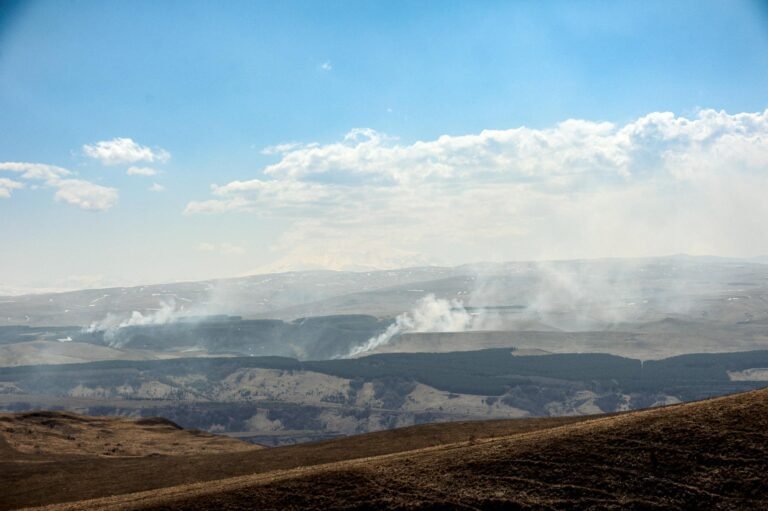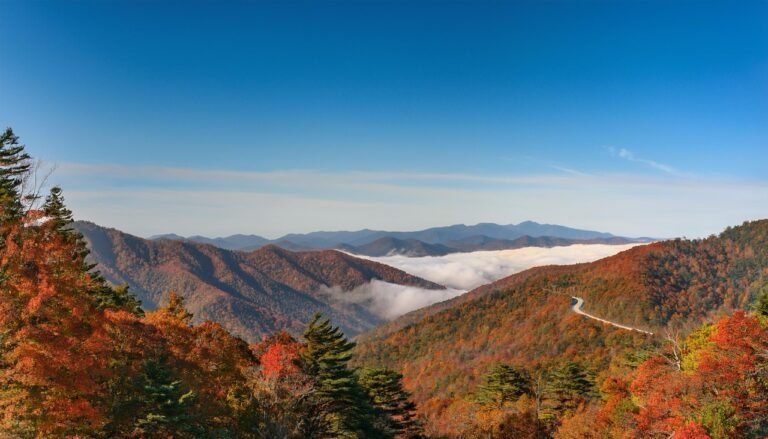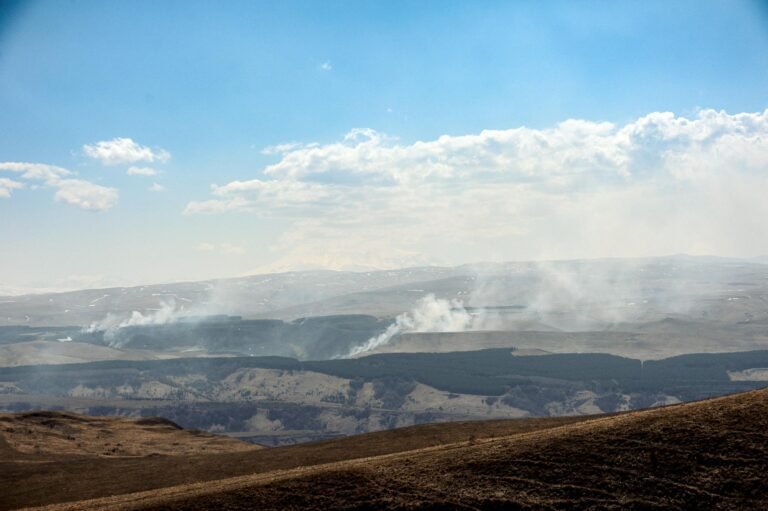Great Smoky Mountains National Park Weather

Planning a trip to the Great Smoky Mountains National Park? Knowing the weather can make or break your adventure. Here’s a quick guide to help you get ready for whatever Mother Nature throws your way.
Understanding Smoky Mountains Weather Patterns
Understanding Great Smoky Mountains National Park weather is crucial for planning a successful visit. The park’s diverse elevations and landscapes contribute to its unique microclimates, making weather patterns both fascinating and sometimes unpredictable.
The Great Smoky Mountains’ weather is influenced by several factors:
- Elevation: Temperature decreases by about 3°F for every 1,000 feet of elevation gain.
- Moisture: The park receives ample rainfall, contributing to its lush forests and numerous waterfalls.
- Seasonal Changes: Each season offers unique weather conditions and natural phenomena.
Rain, Rain, and More Rain
The Smokies are drenched in rain, making it one of the wettest spots in the southeastern U.S. With 55-85 inches of rain each year, the park’s lush, green forests thrive. Here’s a breakdown of what to expect each month:
| Month | Average Rain (inches) | Average Snow (inches) |
|---|---|---|
| January | 4.8 | 2.3 |
| February | 4.8 | 2.3 |
| March | 5.7 | 1.4 |
| April | 4.3 | 0.4 |
| May | 4.8 | 0 |
| June | 4.5 | 0 |
| July | 5.9 | 0 |
| August | 5.0 | 0 |
| September | 4.0 | 0 |
| October | 3.4 | 0 |
| November | 4.3 | 0.5 |
| December | 4.7 | 1.5 |
Want to see where you’re headed? Check out our Great Smoky Mountains National Park map.
Temperature Swings by Elevation
Great Smoky Mountains National Park weather varies significantly from the lower elevations to the mountain peaks. Visitors should be prepared for temperature differences of 10-20 degrees Fahrenheit between the base and the summit of a mountain.
The park’s elevations range from about 875 feet to 6,643 feet, creating big temperature differences. In summer, lower areas can hit the mid-80s°F, while higher spots stay cooler in the 60s°F. Winter lows can drop to 28°F in the valleys and a chilly 15°F up high.
| Elevation (feet) | Average Summer High (°F) | Average Winter Low (°F) |
|---|---|---|
| 875 | 85 | 28 |
| 2,000 | 80 | 25 |
| 4,000 | 70 | 20 |
| 6,643 | 60 | 15 |
Need tips on what to wear? Check out our guide on dressing for variable weather.
Knowing these weather patterns can help you pack right and plan your activities, whether you’re stopping by the visitor center or hitting the hiking trails.
Weather Safety in the Smokies
- Always check the weather forecast before your visit.
- Be prepared for sudden weather changes, especially at higher elevations.
- Carry appropriate gear, including rain gear and warm layers.
- During thunderstorms, seek shelter immediately and avoid exposed areas.
What’s the Weather Like in the Smokies?
The Great Smoky Mountains National Park is a weather chameleon, changing its colors with each season. Knowing what to expect can make your trip a whole lot smoother.
Spring Surprises
Spring (March to May) in the Smokies is like a box of chocolates—you never know what you’re gonna get. One minute it’s sunny and warm, the next it’s raining cats and dogs, or even snowing. Down in the valleys, expect temps between 50°F to 70°F, but head up the mountains and it’s 10 to 15 degrees cooler.
| Month | Average High (°F) | Average Low (°F) | Rain (inches) |
|---|---|---|---|
| March | 60 | 35 | 5.5 |
| April | 70 | 42 | 4.4 |
| May | 77 | 50 | 5.0 |
Summer Sizzle
Summer (June to August) cranks up the heat, humidity, and afternoon thunderstorms. Down low, temps hit the mid-80s, but up high, it’s a comfy 60-something.
| Month | Average High (°F) | Average Low (°F) | Rain (inches) |
|---|---|---|---|
| June | 83 | 58 | 4.6 |
| July | 85 | 62 | 5.1 |
| August | 84 | 61 | 4.9 |
Want to know what to do when it’s hot? Check out things to do in great smoky mountains national park.
Autumn Awesomeness
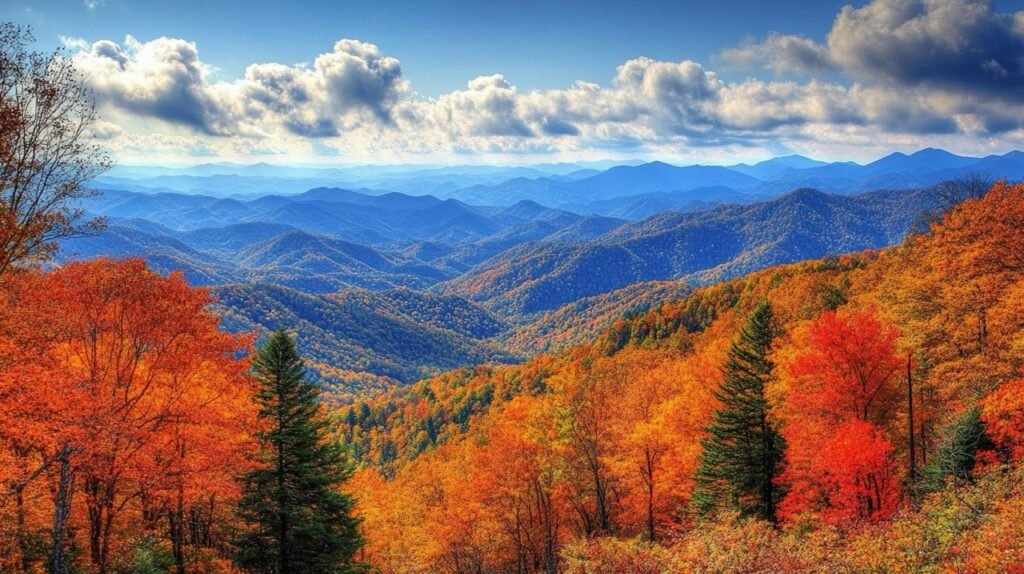
Fall (September to mid-November) is all about cooler temps and jaw-dropping fall colors. Perfect for hiking! Temps range from 70°F in September to 50°F in November down low, and it’s 10 to 15 degrees cooler up high.
| Month | Average High (°F) | Average Low (°F) | Rain (inches) |
|---|---|---|---|
| September | 77 | 55 | 4.3 |
| October | 67 | 44 | 3.1 |
| November | 57 | 36 | 4.3 |
For the best trails to see the fall colors, check out best hikes in great smoky mountains national park.
Winter Wonderland
Winter (mid-November to February) is mostly mild, but don’t be surprised by snow, especially up high. In February, for instance, expect highs around 51°F and lows around 28°F down low, with 4.8 inches of rain and 2.3 inches of snow.
| Month | Average High (°F) | Average Low (°F) | Rain (inches) | Snow (inches) |
|---|---|---|---|---|
| December | 50 | 28 | 4.3 | 1.8 |
| January | 47 | 25 | 4.6 | 2.6 |
| February | 51 | 28 | 4.8 | 2.3 |
Planning a winter adventure? Check out great smoky mountains national park camping.
Knowing the weather in the Great Smoky Mountains can make or break your trip. Whether you’re hiking, camping, or just exploring, always check the latest weather updates. For a detailed map, visit great smoky mountains national park map.
Weather-Related Park Activities

Different weather conditions offer unique opportunities in the park:
- Spring: Witness wildflower blooms and waterfalls at peak flow.
- Summer: Enjoy cooler temperatures at higher elevations for hiking.
- Fall: Experience stunning autumn foliage, especially in October.
- Winter: Try winter sports like cross-country skiing or snowshoeing.
Weather Preparedness Tips
Planning a trip to the Great Smoky Mountains National Park? The weather can be as unpredictable as a cat on a hot tin roof. Here’s how to stay comfy and ready for anything Mother Nature throws your way.
Dressing for Variable Weather
In the Smokies, the weather can flip faster than a pancake. Here’s how to dress so you’re not caught off guard:
- Layer Up: Think of yourself as an onion. Start with a moisture-wicking base layer to keep sweat at bay, add an insulating middle layer for warmth, and top it off with a waterproof and windproof outer layer.
- Footwear: Your feet are your best friends here. Waterproof hiking boots with good ankle support and traction are a must.
- Headgear: A wide-brimmed hat for sunny days and a warm beanie for chilly ones. Keep your noggin happy.
- Gloves: Lightweight gloves for spring and fall, and insulated ones for winter. No one likes cold fingers.
- Rain Gear: A packable rain jacket and pants. Because getting soaked is no fun.
Packing Essentials for All Seasons
Packing smart can make or break your trip. Here’s a cheat sheet for what to bring, no matter the season:
| Item | Spring | Summer | Autumn | Winter |
|---|---|---|---|---|
| Lightweight Layers | ✓ | ✓ | ✓ | |
| Insulating Layers | ✓ | ✓ | ✓ | |
| Waterproof Outer Layers | ✓ | ✓ | ✓ | ✓ |
| Hat and Gloves | ✓ | ✓ | ✓ | |
| Sunscreen | ✓ | ✓ | ✓ | ✓ |
| Bug Spray | ✓ | ✓ | ✓ | |
| Water Bottle or Hydration System | ✓ | ✓ | ✓ | ✓ |
| First Aid Kit | ✓ | ✓ | ✓ | ✓ |
| Map and Compass/GPS | ✓ | ✓ | ✓ | ✓ |
| Flashlight or Headlamp | ✓ | ✓ | ✓ | ✓ |
| Extra Socks | ✓ | ✓ | ✓ | ✓ |
| Snacks/Energy Bars | ✓ | ✓ | ✓ | ✓ |
Don’t forget to grab a Great Smoky Mountains National Park map and swing by the visitor center for more tips and info.
By following these tips and packing the right gear, you’ll be ready for whatever the Smokies throw at you. Whether you’re hiking the best trails or chasing waterfalls, staying ahead of the weather will make your adventure one for the books.
Get more information on National Parks
How Elevation Shapes Weather
Weather Changes with Altitude
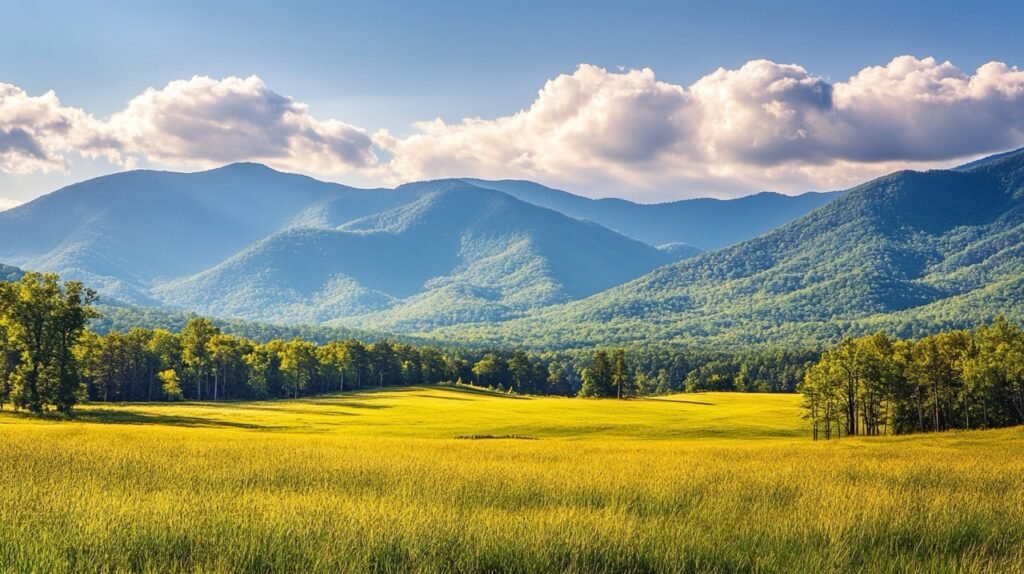
When you head to Great Smoky Mountains National Park, the weather’s got a mind of its own, thanks to the park’s varying elevations. From a low of about 875 feet (267 meters) to a high of 6,643 feet (2,025 meters), the climate shifts as you climb.
| Elevation | Temperature Range (°F) | Average Annual Rainfall (inches) |
|---|---|---|
| Low Elevations (875 feet) | 50-80 | 50 |
| Mid Elevations (3,000 feet) | 40-70 | 60 |
| High Elevations (6,643 feet) | 30-60 | 85 |
Down low, expect warmer temps and less rain. As you go up, it cools off and gets wetter. Up top, it’s chillier and snowier in winter. So, pack smart and be ready for anything. For a closer look at the park’s layout, check out the Great Smoky Mountains National Park map.
Man-Made Weather Woes
Humans have left their mark on the weather in Great Smoky Mountains National Park. Since 1948, visibility in the southern Appalachians has tanked down 40% in winter and a whopping 80% in summer, all thanks to pollution. What used to be a clear 93-mile view is now often just 25 miles, sometimes dropping to less than a mile during heavy haze.
Blame it on power plants, cars, and factories. Sulfate levels shot up by 27% from 1984-1999, mainly from power plants, making the air hazier.
Ozone pollution is another headache. Ozone levels over the park’s ridges are double what you’d find in nearby cities like Knoxville and Atlanta. This pollution comes from power plants, cars, and factories outside the park. High ozone levels can mess with your lungs and harm the park’s trees and plants.
For tips on what to pack and how to dress for the park’s unpredictable weather, check out our weather preparedness tips.
Knowing how the environment affects the park’s weather helps you plan better and enjoy the natural beauty while being aware of conservation efforts. If you’re up for some hiking, don’t miss our guide on the best hikes in Great Smoky Mountains National Park.
Firefly Magic in the Smokies
One of the coolest experiences you can have in the Great Smoky Mountains National Park is catching the firefly show. This amazing event pulls in folks from all over to see nature’s very own light display.
The Synchronized Firefly Show
The fireflies in Elkmont are the rock stars of the bug world. Every year, around early June, they put on a synchronized light show that’s nothing short of jaw-dropping. Because so many people want to see this, the National Park Service has set up a lottery system to handle the crowd.
| Fun Fact | Number |
|---|---|
| Firefly Species in the Park | 19 |
| Global Firefly Fans | 1 million yearly |
| New Species Found by Discover Life in America | 1,000+ |
This event is super popular, so plan ahead. Get your passes through the lottery to make sure you don’t miss out. For a park map, check out the Great Smoky Mountains National Park Map.
What’s Hurting the Fireflies?
Even though they’re magical, fireflies are facing some big problems. Losing their homes, pesticides, and too much light at night are the main issues. In the Smokies, these problems are taken seriously because they could mess up the whole park.
| Problem | What It Does |
|---|---|
| Losing Homes | Less space to live and breed |
| Pesticides | Kills fireflies and their food |
| Too Much Light | Messes up their mating signals |
Saving these little guys is super important. Groups like Discover Life in America are working hard on research and conservation, often teaming up with universities. For more on their work, check out Discovering New Species.
By knowing about these threats and doing your part, you can help keep the firefly magic alive for future generations. When you visit, be mindful of your impact and follow the rules to keep light pollution down. For more tips on enjoying your trip, see our guide on Things to Do in Great Smoky Mountains National Park.
Seeing the firefly show is a must-do in the Great Smoky Mountains National Park. Plan ahead, get your passes, and get ready to be wowed by nature’s light show.
Current Weather Conditions and Alerts
As of September 2024, visitors to Great Smoky Mountains National Park should be prepared for variable weather conditions, especially in the higher elevations where temperatures can be significantly cooler than in the valleys.
The park experiences a warm and humid summer season, with average temperatures ranging from the 70s°F to the 90s°F (20°C to 30°C) and frequent afternoon showers and thunderstorms.
Currently, there are no active weather advisories in effect, but it’s important to stay updated as conditions can change rapidly. The park’s diverse climate means that rainfall can vary significantly, with the lowlands receiving around 55 inches annually, while higher elevations like Clingmans Dome can receive up to 85 inches.
Biodiversity in the Park

The Great Smoky Mountains National Park is a goldmine of life, perfect for nature lovers and families. Let’s dive into the park’s amazing biodiversity, the discovery of new species, and the ongoing efforts to keep it all thriving.
Discovering New Species
Discover Life in America, a nonprofit on a mission to document biodiversity, has found over 10,000 animal and plant species in the Great Smoky Mountains National Park. Even cooler, more than 1,000 of these were totally new to science. This makes the park a hotspot for biological research and discovery.
| Category | Number of Documented Species | Previously Unknown to Science |
|---|---|---|
| Total Species | 10,000+ | 1,000+ |
| Plants | 4,000+ | 500+ |
| Animals | 6,000+ | 500+ |
If you want to see this biodiversity up close, check out the Great Smoky Mountains National Park hiking trails. These trails are your ticket to experiencing the park’s diverse plants and animals firsthand.
Conservation Efforts and Partnerships
The park’s conservation efforts are strong and varied. Discover Life in America teams up with universities and research institutions to protect and study the park’s unique ecosystems. One cool project they run is the synchronous firefly viewing events, where you can see nature’s light show and learn about conservation.
The park also partners with various organizations to keep its biodiversity intact. These efforts include restoring habitats, monitoring species, and running educational programs to help people understand why the park is so important.
Planning a visit? The Great Smoky Mountains National Park lodging options make it easy to stay close to these conservation areas. Plus, the Great Smoky Mountains National Park visitor center has all the info you need on ongoing projects and how you can help out.
By exploring the park’s incredible biodiversity and supporting conservation efforts, you’re helping to preserve this natural wonder for future generations. Don’t forget to check out our guide on things to do in Great Smoky Mountains National Park to make the most of your visit.
Latest News: Great Smoky Mountains National Park Weather Updates
Stay informed about the most recent weather-related news and events in Great Smoky Mountains National Park:
- Seasonal Weather Advisory: The National Park Service has issued a [specific weather advisory] for [season/month]. Visitors are advised to check Great Smoky Mountains National Park weather forecasts regularly and prepare accordingly.
- Trail Conditions: Recent [weather event, e.g., heavy rainfall, snowfall] has affected several popular trails. Park rangers are monitoring Great Smoky Mountains National Park weather impacts on hiking routes. Check the official park website for up-to-date trail information.
- Weather-Related Park Events: The park is hosting a [specific event, e.g., guided hike, photography workshop] focused on Great Smoky Mountains National Park weather phenomena. Learn about [specific weather feature, e.g., cloud formations, fog patterns] from expert naturalists.
- Climate Research: Scientists are conducting new studies on Great Smoky Mountains National Park weather patterns and their effects on local ecosystems. Preliminary findings suggest [brief mention of research outcomes].
- Visitor Center Updates: The [specific visitor center] has unveiled a new interactive exhibit on Great Smoky Mountains National Park weather. Visitors can now experience simulated weather conditions and learn about the park’s unique microclimates.
Frequently Asked Questions: Great Smoky Mountains National Park Weather
What's the best time of year to visit Great Smoky Mountains National Park for good weather?
The best time for pleasant Great Smoky Mountains National Park weather is typically from April to October. Spring offers mild temperatures and blooming wildflowers, while fall brings stunning foliage and comfortable hiking conditions.
How much does the temperature vary between the base and the summit of the mountains?
Great Smoky Mountains National Park weather can vary significantly with elevation. Temperatures typically drop 3-4°F for every 1,000 feet of elevation gain. Expect a 10-20°F difference between the base and summit of mountains.
Does it snow in Great Smoky Mountains National Park?
Yes, snow is common in the higher elevations during winter. Lower elevations may see 1-5 snowfalls per year, while higher areas like Clingmans Dome can receive up to 69 inches annually.
How often does it rain in the Smoky Mountains?
Great Smoky Mountains National Park weather is characterized by frequent rainfall. The park receives 55-85 inches of rain annually, with the wettest months being July and August.
What should I pack for unpredictable weather in the Smokies?
To prepare for variable Great Smoky Mountains National Park weather, pack layers including a waterproof jacket, warm fleece, hat, and gloves. Sturdy hiking boots and extra socks are also recommended.
Are there any weather-related closures I should be aware of?
Some roads, like Clingmans Dome Road, close during winter due to icy conditions. Always check the park's official website for current Great Smoky Mountains National Park weather-related closures before your visit.
What's the average temperature in the Smoky Mountains during summer?
Summer Great Smoky Mountains National Park weather typically features daytime highs in the 80s°F in lower elevations and 60s-70s°F at higher elevations. Nighttime temperatures can drop into the 50s-60s°F.
How does fog affect visibility in the park?
Fog is a common feature of Great Smoky Mountains National Park weather, especially in the mornings and after rainfall. It can reduce visibility significantly, so drive cautiously and allow extra time for scenic views to clear.

